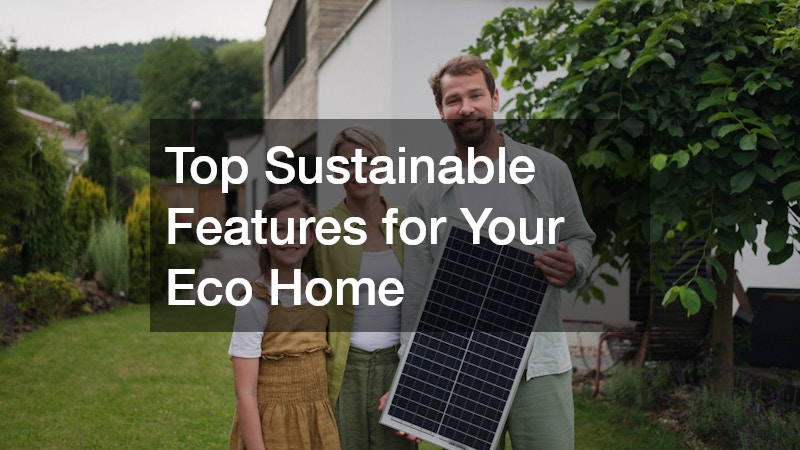Creating a sustainable home goes beyond energy-efficient light bulbs or recycling bins—it involves an integrated approach to how a home functions and interacts with the environment. With rising energy costs, increasing climate challenges, and a growing awareness of our environmental impact, more homeowners are investing in eco-friendly upgrades that not only reduce their carbon footprint but also enhance their property’s long-term value and comfort.
Sustainable home features cover a wide spectrum—from essential systems like heating, cooling, and water management, to structural components and outdoor features. When chosen wisely, these upgrades support resource conservation, minimize pollution, and even generate long-term savings on utility bills. However, navigating the many options available can be overwhelming without a clear understanding of how each feature contributes to an eco-conscious lifestyle.
In this article, we’ll explore the top sustainable features that can transform your home into an eco-efficient sanctuary. Whether you’re upgrading your current residence or building from scratch, the following innovations will help you live more sustainably. From modernizing critical systems to integrating environmentally friendly infrastructure, each category showcases practical, effective ways to build a better future, starting with your own home.
Built for Efficiency and Longevity
The foundation of any sustainable home starts with its structure and building materials. Sustainable features such as energy-efficient roofing services not only enhance a home’s insulation but also reduce energy consumption significantly. Eco-friendly roofing options like cool roofs or solar tiles harness the power of the sun while keeping homes cooler in warm months.
These roofing features are integral to a home’s environmental performance, providing long-term savings on heating and cooling. By choosing durable materials that have lower embodied energy, homeowners can ensure that their roof withstands the test of time while remaining environmentally friendly. Moreover, sustainable roofing increases property value, making it an investment in both the environment and financial future.
Furthermore, sustainable roofing integrates seamlessly with other home systems, promoting a holistic approach to energy efficiency. Reflective coatings and green roofs also offer additional benefits, such as reducing the heat island effect and supporting biodiversity. These features collectively contribute to a more sustainable lifestyle, enhancing both comfort and ecological impact.

Optimizing Indoor Climate Responsibly
Maintaining a comfortable indoor climate sustainably is critical in reducing energy consumption and carbon emissions. Advanced HVAC maintenance offers sustainable features that improve efficiency and reliability. Routine services such as replacing filters, inspecting ductwork, and ensuring proper insulation can significantly enhance system performance.
HVAC maintenance goes hand-in-hand with other sustainable features, optimizing heating and cooling by ensuring that older systems operate at peak performance. Upgrading to smart thermostats and energy-efficient units further decreases energy usage, lowering monthly utility bills. These steps not only contribute to a greener footprint but also extend the life of HVAC systems, delaying the need for replacements.
Incorporating sustainable HVAC practices is not limited to technological solutions alone; lifestyle changes play a key role, such as using curtains to block or filter sunlight and strategic ventilation. Integrating these measures helps maintain indoor air quality with less reliance on artificial climate control. This comprehensive strategy results in a healthier, more balanced indoor environment poised against climate fluctuations.
Eco-Conscious Cooling Solutions
The need for indoor cooling solutions becomes more pronounced as global temperatures rise. Sustainable features for cooling, such as high-efficiency air conditioning and passive cooling designs, are gaining prominence. Proper refrigeration repairs and maintenance ensure that cooling systems run optimally, preventing excess energy consumption.
Eco-friendly cooling solutions encompass not just mechanical systems, but also architectural decisions that facilitate natural airflow and shade. Cross-ventilation, ceiling fans, and window films are affordable ways to reduce reliance on energy-intensive cooling. Each of these approaches contributes to reducing energy demand, safeguarding power resources for the future.
Furthermore, refrigeration repairs and upgrades involve eco-friendly refrigerants and advanced compressor technology, minimizing environmental impact. Maintenance is crucial to prevent leaks and inefficiencies that increase greenhouse gas emissions. By embracing these sustainable features, homeowners can keep their homes cool while supporting broader environmental goals.

Smart Water Management
Water conservation is an essential component of sustainable living. Installing water-efficient fixtures, like low-flow faucets and dual-flush toilets, significantly decreases household water usage. Sustainable features within water management systems, such as rainwater harvesting and greywater recycling, offer creative solutions to traditional water supply challenges.
Water pump services contribute to efficient supply and distribution, ensuring that water systems operate without wasted resources. These services maintain pressure, detect leaks, and ensure seamless integration with rainwater systems. By optimizing water usage, homeowners relay the ripple effect of sustainability throughout their community.
Effective water management extends to landscaping, where drip irrigation systems and native plant choices reduce exterior water consumption. Sustainable landscaping not only saves water but also maintains soil health and supports local ecosystems. Collectively, these features create a resilient water resource strategy, safeguarding against scarcity and associated costs.
Improving Heat Performance the Green Way
Transitioning towards sustainable heating requires a blend of technology and maintenance. Adopting sustainable features in heating systems, like energy-efficient furnaces, enhances heat performance while reducing fuel consumption. Regular furnace repairs and tune-ups preserve system efficiency, ensuring that homes remain comfortable during colder months without excess energy use.
Many homeowners are turning to renewable energy sources, like solar or geothermal heating, to achieve sustainable warmth. While the initial investment may be higher, these systems offer extensive savings over their lifecycle and reduce dependence on fossil fuels. Paired with proper insulation, these updates ensure that homes utilize less energy while maintaining thermal comfort.
Beyond technological upgrades, lifestyle adjustments such as wearing appropriate clothing, using programmable thermostats, and zoned heating can make notable differences in efficiency. These sustainable features collectively contribute to an eco-friendly lifestyle, lowering the ecological footprint while enhancing indoor comfort. These methods align seamlessly with modern environmental guidelines and financial strategies.

Passive Cooling and Shade Benefits
Passive cooling and shading are valuable components of a sustainable home, capitalizing on the natural climate for indoor comfort. Features like awning installations reduce solar gain, helping homes remain cooler with less mechanical air conditioning. Carefully chosen window treatments block excessive sunlight, providing both environmental and aesthetic benefits.
Sustainable design often employs architectural shading elements to minimize heat absorption. Porches, pergolas, and angled roofs reflect the sun’s rays while creating attractive outdoor spaces. These sustainable features simultaneously reduce energy use and add to the architectural appeal of a home.
Maximizing shade through awnings and other elements aligns with passive cooling principles. They protect interior spaces, reduce energy demand, and ultimately lower the homeowner’s carbon footprint. In addition to increased comfort, these solutions reduce utility costs and add to the longevity of interior furnishings by limiting UV exposure.
Powering Sustainably and Reliably
Reliable power is vital for modern living, and sustainable features help deliver energy without environmental compromise. Home generators powered by renewable resources or efficient fuel options ensure that homes remain operational during outages. These generators provide contingency power, integrating seamlessly with the existing electrical grid.
Solutions such as solar panels or wind turbines convert renewable energy into electricity, reducing dependence on non-renewable sources. Battery storage technologies offer homes the flexibility to store power for use during peak demand times, contributing to grid stability and household adaptability. Coupled with energy-conscious behavior, these measures reflect a commitment to sustainable living.
To fully maximize these benefits, electrical panel upgrades may be necessary to handle increased loads and complex energy flows. These upgrades not only facilitate renewable energy integration but also improve safety, energy efficiency, and handling capacity. By proactively managing electrical systems, homeowners enhance reliability and contribute to a more sustainable energy landscape.
In addition to large-scale systems like solar or wind, smaller strategies such as installing energy monitors, smart plugs, and programmable power strips can also play a significant role in reducing energy waste. These tools allow homeowners to track real-time consumption, identify inefficient appliances, and make informed adjustments that lower overall usage. When integrated with renewable energy sources and home automation systems, they create a highly responsive energy ecosystem that adjusts to household needs while minimizing environmental impact. Together, these technologies empower homeowners to take control of their energy consumption, reinforcing the link between everyday habits and long-term sustainability.
Guarding Against Nature’s Wear and Tear
Protecting a home from natural elements requires a careful selection of materials and techniques. Erosion control products are sustainable features that protect landscapes while preventing soil degradation. Materials like coir logs, willow walls, and bioengineering solutions maintain soil integrity and add an ecological touch to erosion management.
Ground covers, contour planting, and terracing are pragmatic approaches that impede soil erosion while adding to the property’s visual appeal. Erosion control ensures that properties remain structurally sound, minimizing losses from landslides and water damage. This, in turn, maintains a stable platform for other sustainable projects like rain gardens or xeriscaping.
Combining these methods offers a multi-layered defense that enhances both aesthetics and environmental performance. These sustainable features provide functional beauty to the landscape, encouraging biodiversity and preventing further ecological degradation. As weather conditions become more unpredictable, such strategic planning becomes integral to long-term landscape conservation.
Structural Stability With Green Benefits
Ensuring structural stability with sustainable features offers dual benefits: safety and environmental responsibility. Retaining walls, built using sustainable materials, provide foundational support while complementing the landscape’s natural aesthetics. When constructed with permeable materials or recycled content, these structures harmonize with eco-conscious principles.
These walls prevent land slippage, support terraced gardening, and offer peace of mind under changing climatic conditions. Additionally, they control water drainage and reduce erosion, preserving soil and landscape integrity. Retaining walls underline the commitment to sustainable living by integrating sturdy structures with ecological considerations.
Planting native vegetation on and around retaining walls further enhances ecological value, providing habitat and support while maintaining site stability. Each of these measures represents a forward-thinking approach to structural management, ensuring property resilience and sustainability. The aesthetic and pragmatic blends reflect an understanding of both form and function within green building practices.
Modernizing for Energy Demand and Safety
Many homeowners face the challenge of modernizing outdated electrical systems to meet current energy demands safely. Sustainable features such as electrical panel upgrades ensure that homes can accommodate new technology and increased power needs. Up-to-date panels prevent overloads, lowering the risk of electrical fires while contributing to energy efficiency.
These upgrades open the door for smart home technologies, allowing for greater control over energy use through automated systems. They also help integrate renewable energy sources like solar or wind, making them indispensable for a sustainable future. By investing in infrastructure, homeowners are better positioned to respond to energy fluctuations and new advancements.
Moreover, electrical panel upgrades extend beyond efficiency; they enhance overall home safety and reliability. By mitigating potential risks and energy waste, these updates exemplify the intersection between sustainability and protection. As residences evolve to meet future needs, ensuring the safe and efficient distribution of electricity remains paramount.
Building a sustainable home is no longer a luxury—it’s a responsibility and a smart investment. As climate conditions evolve and energy resources fluctuate, equipping your home with eco-friendly features ensures resilience, comfort, and financial efficiency. Each element discussed plays a crucial role in reducing your ecological footprint and promoting long-term well-being.
Upgrading your roofing, HVAC systems, and refrigeration contributes to efficient energy use and climate control. Enhancements like water management systems and furnace upgrades help you conserve resources while improving household reliability. Even elements you might not immediately associate with sustainability—like awnings, retaining walls, or erosion control solutions—contribute significantly to a home’s eco-performance by protecting it from excessive heat, water damage, or soil loss.
Incorporating backup power and upgrading electrical infrastructure ensures that your home can operate efficiently even under demanding conditions. These investments create a more autonomous, low-impact home that aligns with modern sustainability standards.
As you consider which features to prioritize, remember that sustainability is not just about technology—it’s about making thoughtful choices that support your health, your budget, and the planet. By adopting the right combination of innovations, your eco home can serve as both a safe haven and a model of responsible living. Whether you’re just starting or deep into your green journey, these features will help future-proof your home and make a lasting positive impact.



